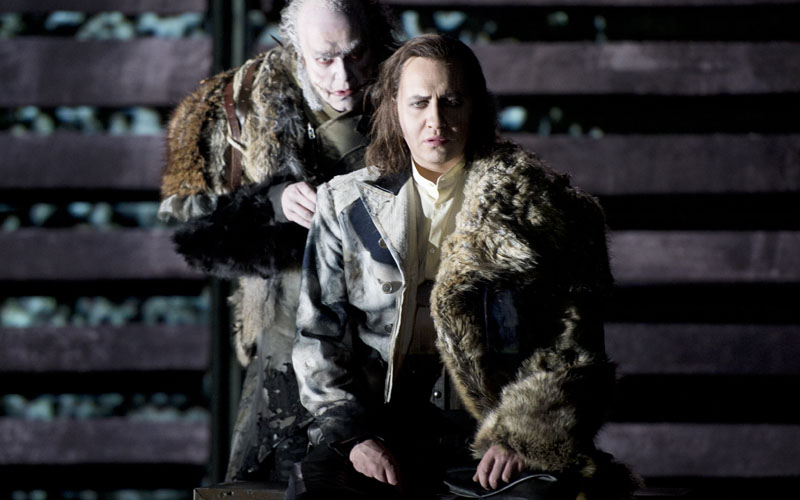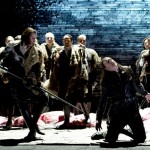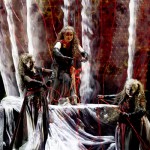
The typical image of a visit to the opera is associated with elegantly dressed ladies, men in tuxedos, glasses of sparkling champagne, and polite conversations. However, at the end of February, ECLA of Bard students had the rare opportunity to get a glimpse behind the curtains of the shiny art world, by attending a rehearsal of Richard Wagner’s Götterdämmerung at the Schiller Theater in Berlin. Götterdämmerung is recognized as one of the most difficult operas to perform, both for the soloists and the musicians.
Götterdämmerung is the final part of Der Ring des Nibelungen (The Ring of the Nibelung), an opera cycle by Richard Wagner that also includes Das Rheingold, Die Walküre and Siegfried – altogether around 15 hours of opera. The first complete performance of the Ring took place on 17 August 1876 at the Bayreuth Festspielhaus, which will be celebrating this year the 200th anniversary of the Leipzig-born composer through a special production of the cycle. Even though Leipzig and Bayreuth will be the main headquarters of the anniversary, Berlin will join in the celebrations as well: local opera admirers will have the chance to experience a production of the Ring cycle infused with video art and contemporary scenery by Guy Cassiers, and to enjoy the orchestra guided by no other than Daniel Barenboim, considered the most prominent Wagner conductor alive.
Our theater visit was preceded by a lecture by Prof. Michael Steinberg of Brown University, who currently serves as a dramaturg to the production of Wagner’s Ring of the Nibelung at the Teatro alla Scala, Milan, and at the Berlin State Opera/Schiller Theater. Those of us who attended the lecture became acquainted with the feats and innovations that would await us during the rehearsal. Upon arrival at the theater, we went backstage and were immediately introduced to an entrenched superstition: one shouldn’t wear hats or coats on the stage, it brings bad luck! After we got rid of the ill-fated apparel, members of the production team gave us a short backstage tour: we sat in awe in front of a massive set for Verdi’s Aida, and were captivated by fragments of video art and a plastic sack with bloody prop hands used in Götterdämmerung.
Before taking my seat in the hall, I had the chance to look in the orchestra pit at a famous ensemble of six harps, a structure that was first introduced to the musical world in the Ring cycle. Wagner’s innovative approach to the orchestra deserves a blog post of its own: for most of his operas, Wagner either upgraded the existing instruments (like the bass trumpet or the contrabass trombone), or created new ones, later named after him (the Wagner tuba and the Wagner bell). The groundbreaking ideas of this ingenious composer influenced and inspired not only the orchestra, but also the opera vocalists and the general performance structure. The originator of the genre of music-drama, Richard Wagner preferred a complex approach and replaced the typically fragmented arias and duos with dramatic monologues and dialogues. The extraordinary duration of operas and the exacting vocal parts require pushing the voice to its limits and tremendous endurance. Thus, voices that can assert themselves over an orchestra of more than 80 pieces got the name of Wagnerian sopranos or tenors—and the case is the same with musical instruments.
As this huge variety of instruments makes Wagner’s pieces monumental and even somewhat oppressive, I could hardly imagine how it would fit on the small stage of the Schiller Theater. However, due to the absence of a couple of artists, the singers didn’t have to work at full capacity. Sitting on the twelfth row of a relatively small hall, I sometimes found it hard to hear the soloists. And since this was a rehearsal, the musical phrases were often interrupted or stopped by “voices from above” (most times, it was the conductor), who took their time making comments in German. It was thrilling to see how the performance was being polished, although it was difficult to get a sense of the final version out of these raw elements—the permanent pauses prevented immersion in the performance. The video art—which I had never seen in an opera performance before—was nevertheless spectacular: the constant motion of natural elements like falling leaves, spurts of flames or the flow of water alternated with intertwined naked bodies in a slow continuous rhythm, thus seeming to react to every movement on stage.
Those who want to see the final result of this intriguing five and a half hour-long performance, as well as the other parts of the Ring cycle, should book the tickets for the Easter FESTTAGE festival, taking place at the end of March: Das Rheingold will be staged on 23 March, Die Walküre – on 24 March, Siegfried – on 27 March and finally Götterdämmerung – on 31 March. Since these operas are rarely performed together, it is a great chance to get acquainted with the Wagnerian musical and vocal style, to commemorate the anniversary of one of the most outstanding German composers, and to add a 15-hour opera marathon to the list of amazing things achieved in life.








